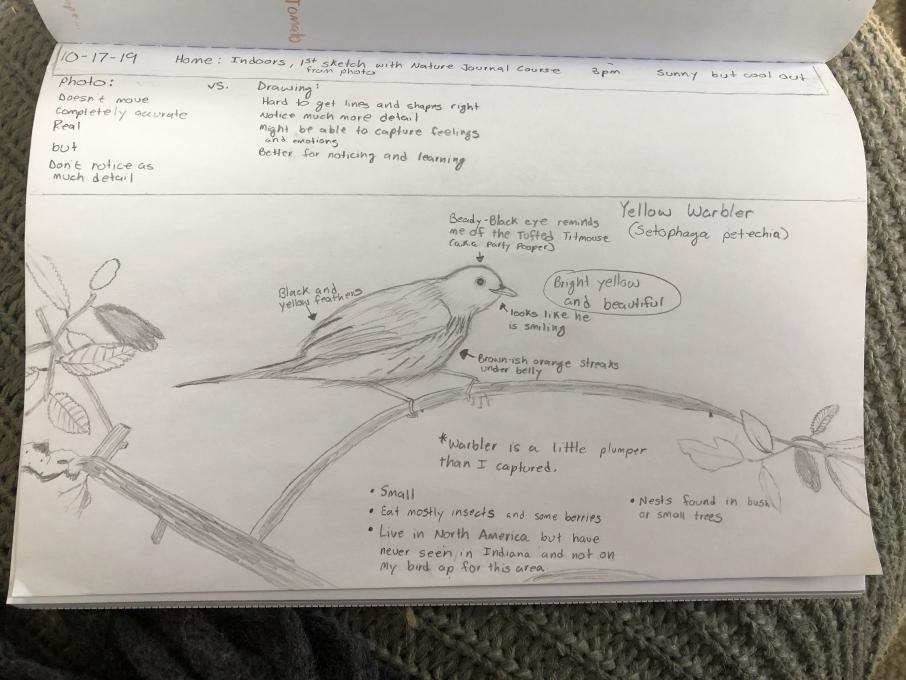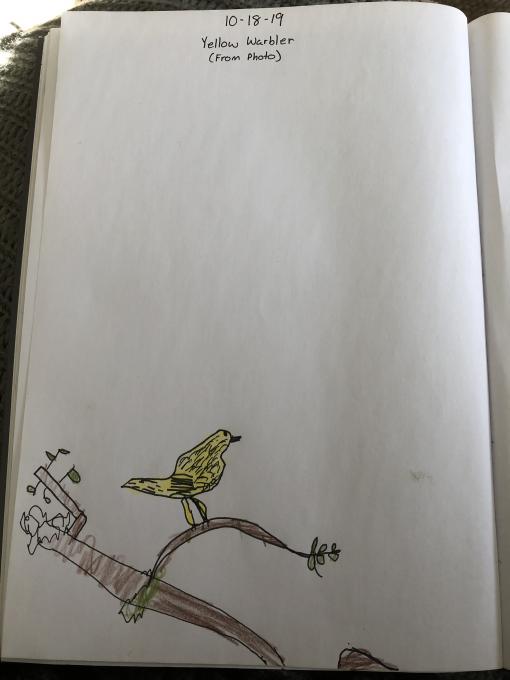The Cornell Lab Bird Academy › Discussion Groups › Nature Journaling and Field Sketching › Jump Right in!
-
 I finally figured out how to post a picture of the correct size. I enjoyed drawing from the picture, the feet and getting the right angle of the bird was challenging. I wouldn’t have noticed the stripes on the stomach so much if I wasn’t drawing them.
I finally figured out how to post a picture of the correct size. I enjoyed drawing from the picture, the feet and getting the right angle of the bird was challenging. I wouldn’t have noticed the stripes on the stomach so much if I wasn’t drawing them. -

-

-

-
1. How did you feel about drawing from the photo? What came easily and what was challenging? I like drawing from photos because it takes away from the challenge of a moving subject. The challenge of birds, for me, is their beaks. Each bird species beak is different and unique to their role in the natural world but I can never seem to get the shape perfect!! 2. Was there anything in the photo that you might not have noticed if you weren’t asked to draw it? Would this make a difference when nature journaling? The branches are so beautiful. If I wasn't asked to draw it, I probably never would have noticed the colors and details in the branches. It definitely would make a difference in nature journaling. Being able to catch a moment in time is so amazing, being able to notice these small details quickly and efficiently so we could capture them is super important... and really fun.
-
I agree with you about the branches. Lichens always seem very inconspicuous, but they’re so colorful and uniquely patterned when you look at them up close.
-
-
1. My biggest challenge in drawing from the photo was getting the proportions of the warbler correct. Something to continue working on. Coloring with the water colors was fairly easy, especially since this is really my first time working with watercolors in a serious way. 2. I needed to pay much more attention to the detail in the coloration of the feathers than I would have if I was not drawing from the photo. This would make a difference if I was drawing a live
 bird that was standing still, which is not usually the case. Drawing from real life subjects has to be much quicker and with less detail, before the bird flies away.
bird that was standing still, which is not usually the case. Drawing from real life subjects has to be much quicker and with less detail, before the bird flies away. -
It took me many attempts (in pencil) and erasures to get the shape of the bird correct. I don't think any part of it was really easy. I noticed more details about the warbler, where it has black and where it has it's orange stripes. Also that the eye is at the same level as the beak, I though it would be above the beak a bit.

-
1. This was a little difficult for me, as I do not feel that I draw very well. I have some problem determining relative distances in the photo, and had to erase a lot. It also felt good that I was able to draw a recognizable image! 2. I did notice details, like the lichen on the limb, and the shading on the bird. I think this would make a big difference in drawing accurate representations of birds and their habitats.
-
 1. It's been a while since I've had basic drawing skills. I started with the ovals and circles and just kept going.
2. Drawing the bird really showed me how to look at the bird. I wouldn't have noticed the subtle shading and wing texture. I think the nature journaling will improve my observational skills. Looking forward to learning about adding color.
1. It's been a while since I've had basic drawing skills. I started with the ovals and circles and just kept going.
2. Drawing the bird really showed me how to look at the bird. I wouldn't have noticed the subtle shading and wing texture. I think the nature journaling will improve my observational skills. Looking forward to learning about adding color. -

-
Using a photo is not too challenging as the subject does not move. That being said, I often use photo references in creating art but I also rely on my sketches and experience as well. Photos can help with details.
-
 I'm a little behind but I enjoyed drawing the warbler, cant wait to add color
I'm a little behind but I enjoyed drawing the warbler, cant wait to add color -
 Drawing from a photo bird is easier than the real bird for obvious motion reasons.My own pet birds are suspicious of my movements and the art tools I am using if I try drawing them. I think the limits of trying to catch the bird in action and the environment, including weather/lighting might be frustrating but I also think the "catch the moment" approach my give the study more "life". I did not feel pressure to finish it as i knew I could come back to it according to my work schedule so that may also be an option if I photograph something that I want to continue on.Using the water color medium requires patience and moments of timing depending on technique/methods so I am wondering if maybe using watercolor pencils/crayons etc might be more forgiving in that sense? My mother was an art teacher/watercolorist and would frown on copying from photos as she said one would lose the joy of life in the moment. I have felt similar but there are times one is limited with time and materials. I might have not noticed the lichen or the "eaten" leaves in the process which I did not spend much time on especially with the leaf position. Also maybe the rust streaks on the bird may not have been as apparent if I had drawn from life.
It was fun to do and I know I have to literally brush up on my watercolor skills.
Drawing from a photo bird is easier than the real bird for obvious motion reasons.My own pet birds are suspicious of my movements and the art tools I am using if I try drawing them. I think the limits of trying to catch the bird in action and the environment, including weather/lighting might be frustrating but I also think the "catch the moment" approach my give the study more "life". I did not feel pressure to finish it as i knew I could come back to it according to my work schedule so that may also be an option if I photograph something that I want to continue on.Using the water color medium requires patience and moments of timing depending on technique/methods so I am wondering if maybe using watercolor pencils/crayons etc might be more forgiving in that sense? My mother was an art teacher/watercolorist and would frown on copying from photos as she said one would lose the joy of life in the moment. I have felt similar but there are times one is limited with time and materials. I might have not noticed the lichen or the "eaten" leaves in the process which I did not spend much time on especially with the leaf position. Also maybe the rust streaks on the bird may not have been as apparent if I had drawn from life.
It was fun to do and I know I have to literally brush up on my watercolor skills. -

-

-
1. Wow, I was not sure about it but then I was like "I'm doing it!" I would say it came easily because it was a still shot and I could zoom in if I wanted to see details. I took my time and really enjoyed it. It was therapeutic:) 2. I think maybe the finer details, the positioning of the feet/talons, the moss, the beak and different colors on the Warbler ... I might not have noticed the leaves/surroundings, I probably would have noticed just the Warbler alone.

-
Drawing from a photo has always been easier than drawing from my memory. Not to hard but a long way from great.
-
1. It took a while to get my confidence up to draw again...especially after seeing the wonderful sketches already posted! I spent quite a bit of time on the head until I felt I got the angle correct. Heads have always been a challenge. The angle, the eye, the position of the beak give the bird its personality and most of my bird drawings look flat. I went back to my John Muir Laws book to get some help. This is one of the better heads I’ve done. Eyes and legs/feet are relatively easy since I spent time in my last class on studies of them. I think the big challenge will be to quicken my sketching pace. This drawing took me a bit of time. 2. It wasn’t so much the bird as the branches and leaves. I might not have paid attention to the lichens and moss or the roughness of the branches. I’d think that in nature journaling we want these kinds of details since they can lead to questions we might not have thought about or lead to identifications we might want. I’m pretty satisfied with the first drawing but expect I’m going to have to learn to speed up a bit since nature doesn’t sit still.

-
I am a beginning drawer and so I found the outline shape and beak a little challenging, and had to erase several times to try to make it more accurately represent the photo.
 If I weren't trying to draw it I wouldn't have been as aware of how the striations on the breast and wing varied. Becoming a better observer of the world around me is my primary reason for taking the course, so this first exercise has been affirming in that regard.
If I weren't trying to draw it I wouldn't have been as aware of how the striations on the breast and wing varied. Becoming a better observer of the world around me is my primary reason for taking the course, so this first exercise has been affirming in that regard. -
 1. How did you feel about drawing from the photo? What came easily and what was challenging?
It’s hard to get the key features out of a real photo as all the detail is present. how is the feather laid out and where shall I draw shadow? How light/heavy is the shadow? Sometimes the shadow makes the drawing dirty. How to make the feather look fuzzy?
2. Was there anything in the photo that you might not have noticed if you weren’t asked to draw it? Would this make a difference when nature journaling?
The way the feather arranged on the back, it has many layers of different textures.
the bill which has two distinct colors on the top &bottom
1. How did you feel about drawing from the photo? What came easily and what was challenging?
It’s hard to get the key features out of a real photo as all the detail is present. how is the feather laid out and where shall I draw shadow? How light/heavy is the shadow? Sometimes the shadow makes the drawing dirty. How to make the feather look fuzzy?
2. Was there anything in the photo that you might not have noticed if you weren’t asked to draw it? Would this make a difference when nature journaling?
The way the feather arranged on the back, it has many layers of different textures.
the bill which has two distinct colors on the top &bottom -
 I need to stop thinking of myself as a plagiarist when I copy a photo or a drawing. It was fun to take the time to notice so much detail. A Yellow Warbler is fairly obvious to identify, but I am now much more tuned in to coloring beyond his beautiful yellow.
I need to stop thinking of myself as a plagiarist when I copy a photo or a drawing. It was fun to take the time to notice so much detail. A Yellow Warbler is fairly obvious to identify, but I am now much more tuned in to coloring beyond his beautiful yellow. -
1. Birds are really fast so that's way I love photos . I travel the world to see birds and photos let me really see the birds close up . There are many features I would never be able to see. I also can go back and review them. 2, However , trying to draw them is really wonderful also. it makes us slow up and enjoy the environment. I remember their features better because I have to try and be exact on what I am sketching. I have not draw for at least 20yrs so this class is really fun for me.

-
1. The photo makes it easier to sketch as it doesn’t move so have time to study the bird in more detail. The body shape came more easily than the feathers. I didn’t capture the fluffiness of the feathers and the claws were difficult. 2. I noticed little of the branch it was sitting on. I think I noticed more detail in the wing than I might have and certainly about it’s general shape. I may have been more apt to overlook the details.

-
1. I liked drawing from a photo as it gave me time to get my shapes close to accurate. The subject didn't move which is hard to say of those cute little birds! I don't think I could sketch as well with a moving object at this point. I still found it difficult to capture the angel and expression of the bird. I tweaked the beak a bit after seeing a few others drawings and that helped my bird have a little more expression. My oldest son enjoyed it and my youngest son refused to do the drawing...haha. 2.There was tons of details I wouldn't have paid as much attention to if it wasn't for drawing it. It is interesting how much my nature journal page has changed in design/layout in just this first entry! Here is mine and my oldest sons drawings.


-
I love your son’s attention to the detail of the lichen, and his placement of the stems and leaves. You both did a great job!
-
-
1. I love the opportunity to sketch warblers; they seems like such rare glimpses when I spot one. I felt like I had the body proportions ok, but it was challenging for me to illustrate the fluffiness of some of the wings, and also present the bird as not from a full side angle (though I won't know that next time I look at my representation ;-) ). 2. I wouldn't have noticed the details of the beak, or the type of branch (which I didn't even draw clearly, as I focused more on the bird itself); or the variety and differences of feathers. It really helped me look for details and notice them.
Read More:
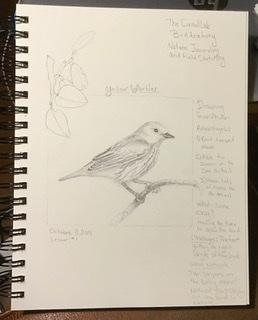 I finally figured out how to post a picture of the correct size. I enjoyed drawing from the picture, the feet and getting the right angle of the bird was challenging. I wouldn’t have noticed the stripes on the stomach so much if I wasn’t drawing them.
I finally figured out how to post a picture of the correct size. I enjoyed drawing from the picture, the feet and getting the right angle of the bird was challenging. I wouldn’t have noticed the stripes on the stomach so much if I wasn’t drawing them. 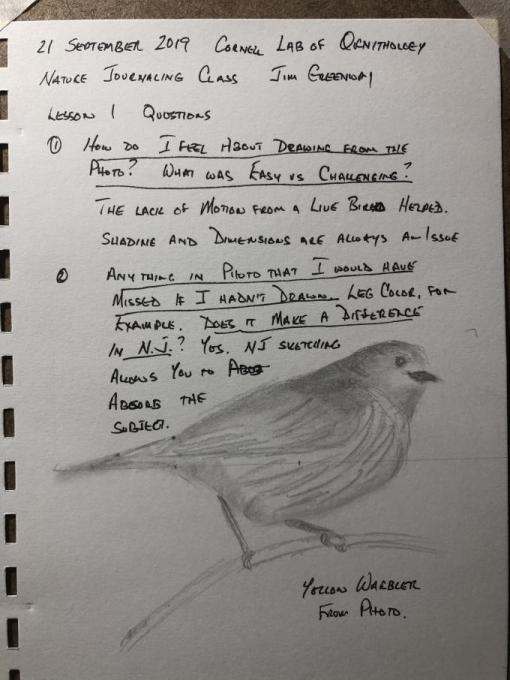

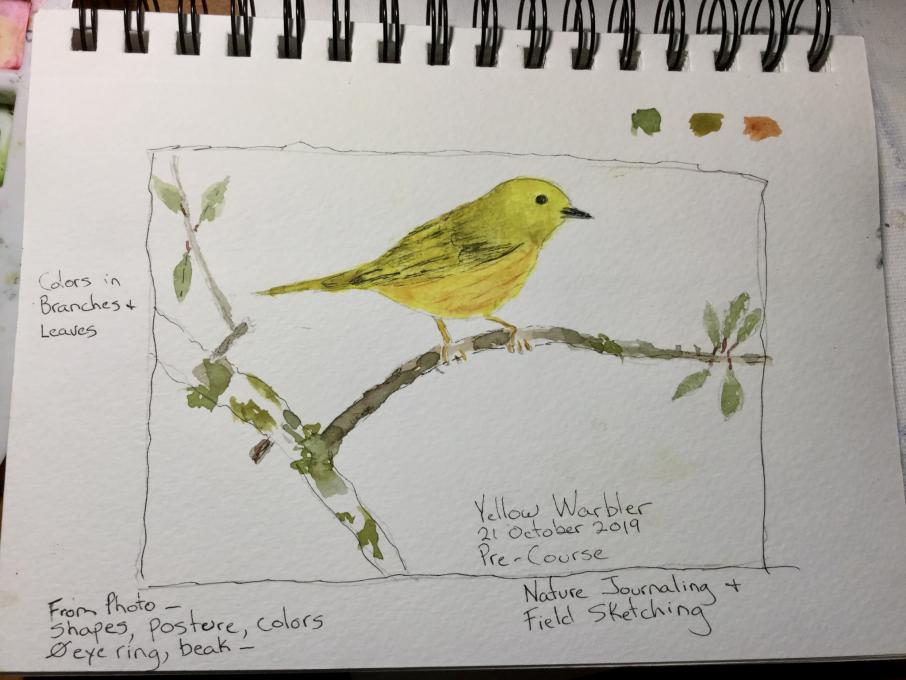
 bird that was standing still, which is not usually the case. Drawing from real life subjects has to be much quicker and with less detail, before the bird flies away.
bird that was standing still, which is not usually the case. Drawing from real life subjects has to be much quicker and with less detail, before the bird flies away. 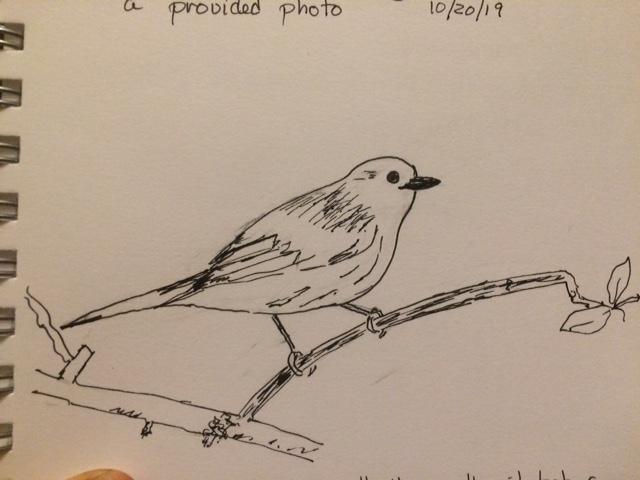
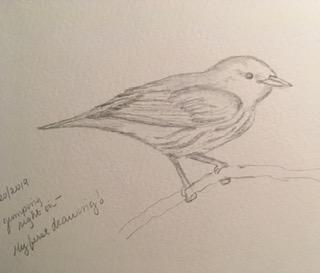 1. It's been a while since I've had basic drawing skills. I started with the ovals and circles and just kept going.
2. Drawing the bird really showed me how to look at the bird. I wouldn't have noticed the subtle shading and wing texture. I think the nature journaling will improve my observational skills. Looking forward to learning about adding color.
1. It's been a while since I've had basic drawing skills. I started with the ovals and circles and just kept going.
2. Drawing the bird really showed me how to look at the bird. I wouldn't have noticed the subtle shading and wing texture. I think the nature journaling will improve my observational skills. Looking forward to learning about adding color. 
 I'm a little behind but I enjoyed drawing the warbler, cant wait to add color
I'm a little behind but I enjoyed drawing the warbler, cant wait to add color 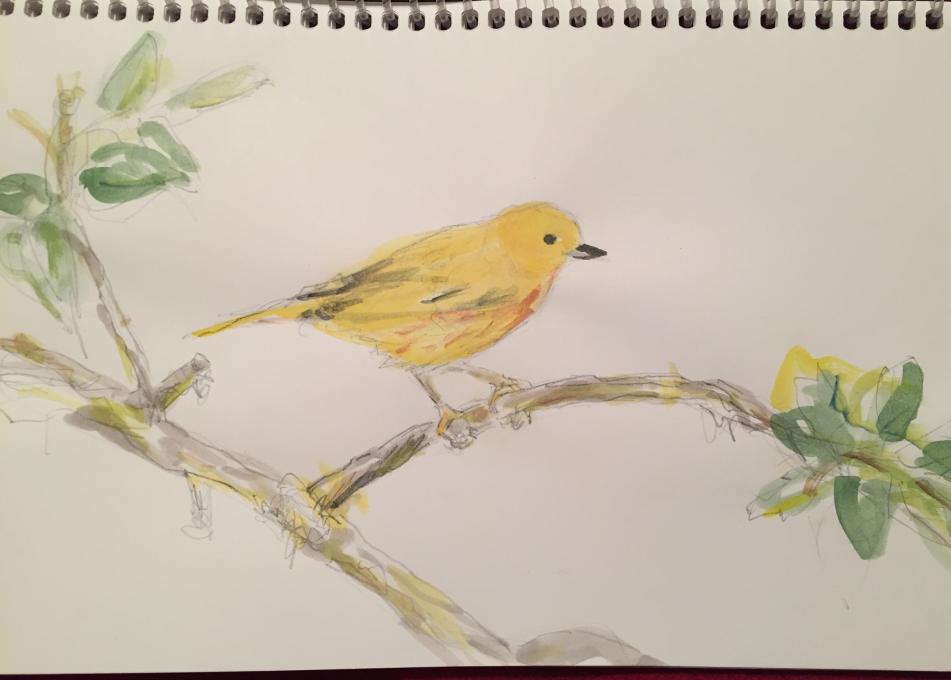 Drawing from a photo bird is easier than the real bird for obvious motion reasons.My own pet birds are suspicious of my movements and the art tools I am using if I try drawing them. I think the limits of trying to catch the bird in action and the environment, including weather/lighting might be frustrating but I also think the "catch the moment" approach my give the study more "life". I did not feel pressure to finish it as i knew I could come back to it according to my work schedule so that may also be an option if I photograph something that I want to continue on.Using the water color medium requires patience and moments of timing depending on technique/methods so I am wondering if maybe using watercolor pencils/crayons etc might be more forgiving in that sense? My mother was an art teacher/watercolorist and would frown on copying from photos as she said one would lose the joy of life in the moment. I have felt similar but there are times one is limited with time and materials. I might have not noticed the lichen or the "eaten" leaves in the process which I did not spend much time on especially with the leaf position. Also maybe the rust streaks on the bird may not have been as apparent if I had drawn from life.
It was fun to do and I know I have to literally brush up on my watercolor skills.
Drawing from a photo bird is easier than the real bird for obvious motion reasons.My own pet birds are suspicious of my movements and the art tools I am using if I try drawing them. I think the limits of trying to catch the bird in action and the environment, including weather/lighting might be frustrating but I also think the "catch the moment" approach my give the study more "life". I did not feel pressure to finish it as i knew I could come back to it according to my work schedule so that may also be an option if I photograph something that I want to continue on.Using the water color medium requires patience and moments of timing depending on technique/methods so I am wondering if maybe using watercolor pencils/crayons etc might be more forgiving in that sense? My mother was an art teacher/watercolorist and would frown on copying from photos as she said one would lose the joy of life in the moment. I have felt similar but there are times one is limited with time and materials. I might have not noticed the lichen or the "eaten" leaves in the process which I did not spend much time on especially with the leaf position. Also maybe the rust streaks on the bird may not have been as apparent if I had drawn from life.
It was fun to do and I know I have to literally brush up on my watercolor skills. 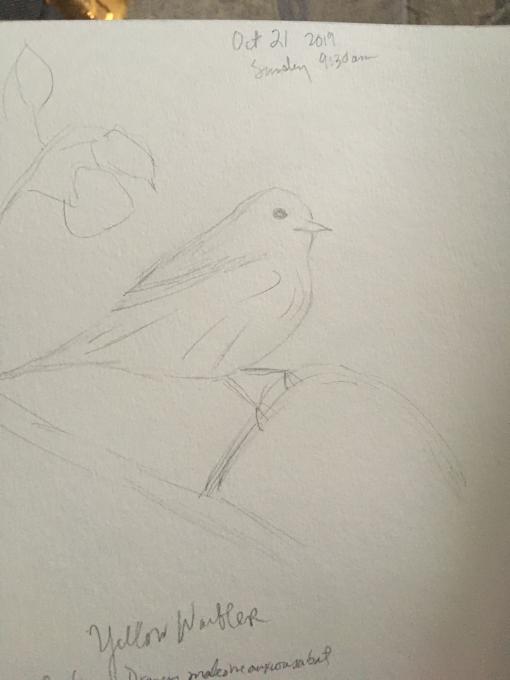

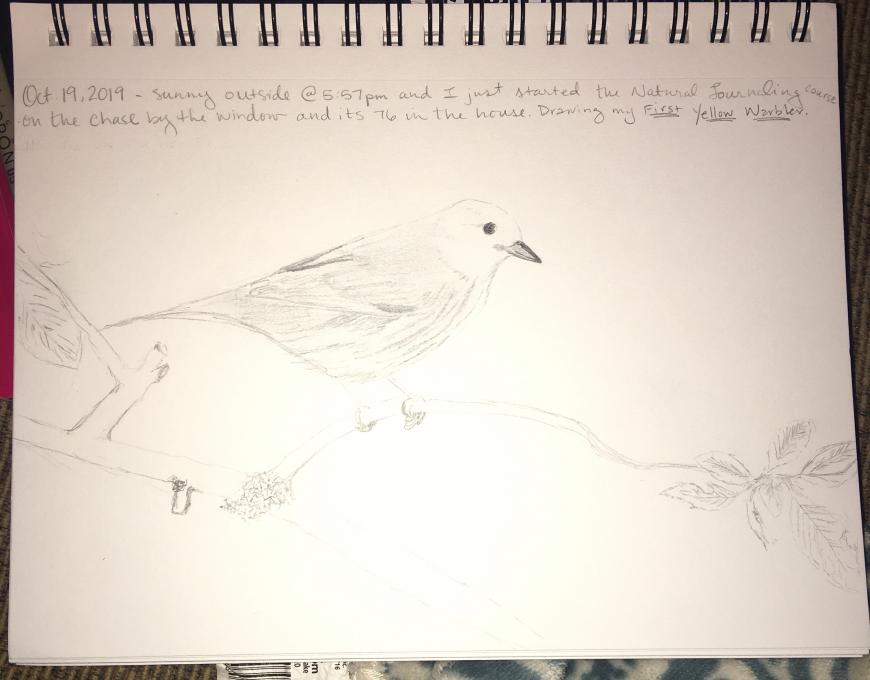
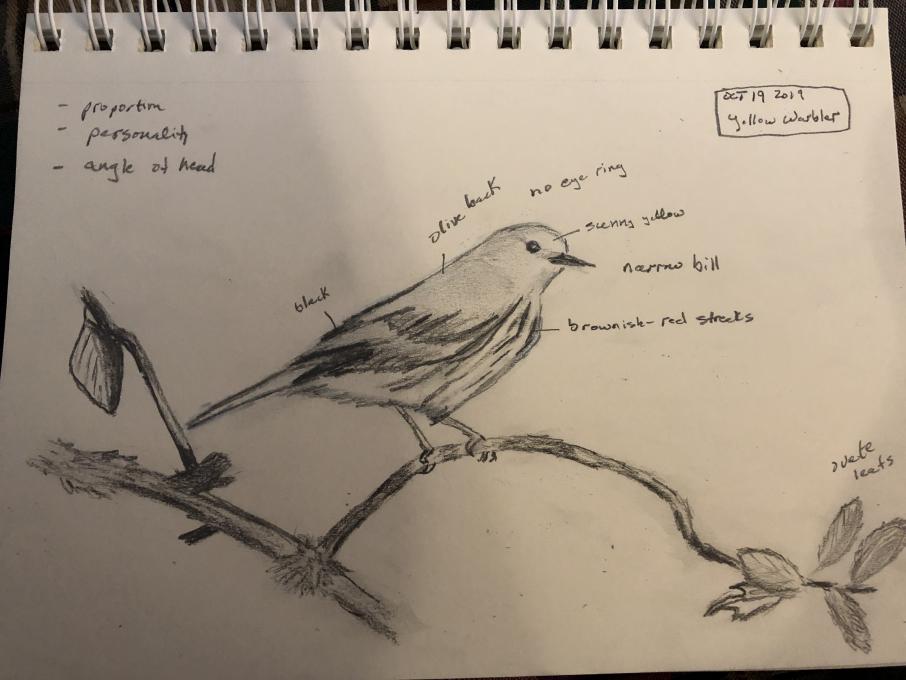
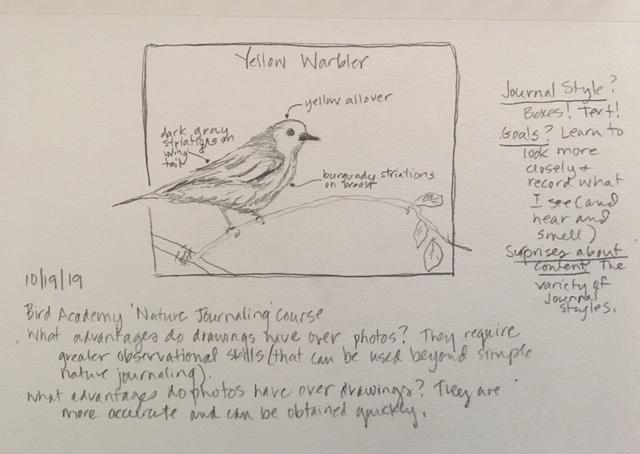 If I weren't trying to draw it I wouldn't have been as aware of how the striations on the breast and wing varied. Becoming a better observer of the world around me is my primary reason for taking the course, so this first exercise has been affirming in that regard.
If I weren't trying to draw it I wouldn't have been as aware of how the striations on the breast and wing varied. Becoming a better observer of the world around me is my primary reason for taking the course, so this first exercise has been affirming in that regard. 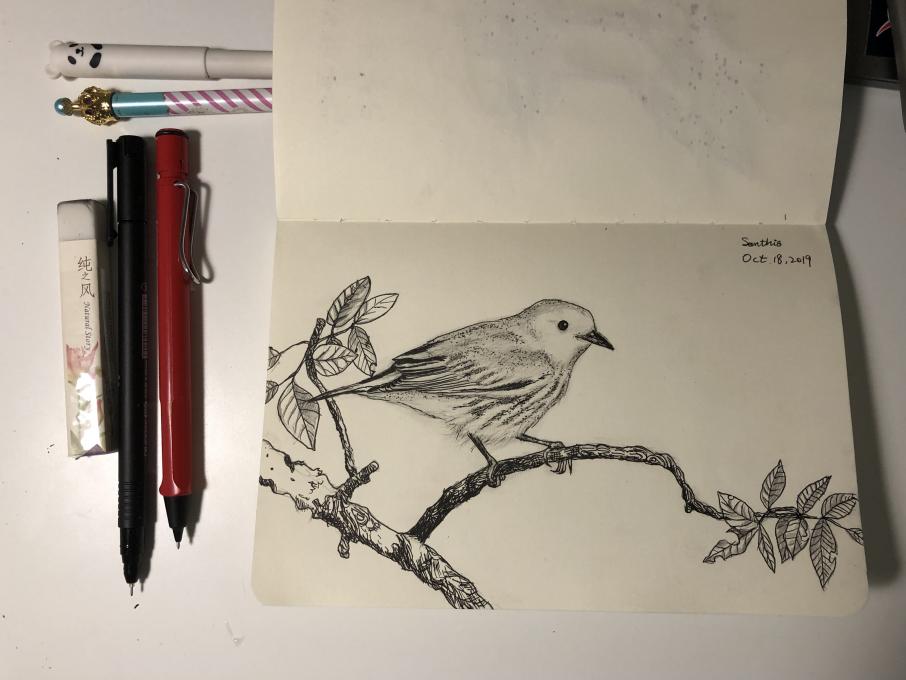 1. How did you feel about drawing from the photo? What came easily and what was challenging?
It’s hard to get the key features out of a real photo as all the detail is present. how is the feather laid out and where shall I draw shadow? How light/heavy is the shadow? Sometimes the shadow makes the drawing dirty. How to make the feather look fuzzy?
2. Was there anything in the photo that you might not have noticed if you weren’t asked to draw it? Would this make a difference when nature journaling?
The way the feather arranged on the back, it has many layers of different textures.
the bill which has two distinct colors on the top &bottom
1. How did you feel about drawing from the photo? What came easily and what was challenging?
It’s hard to get the key features out of a real photo as all the detail is present. how is the feather laid out and where shall I draw shadow? How light/heavy is the shadow? Sometimes the shadow makes the drawing dirty. How to make the feather look fuzzy?
2. Was there anything in the photo that you might not have noticed if you weren’t asked to draw it? Would this make a difference when nature journaling?
The way the feather arranged on the back, it has many layers of different textures.
the bill which has two distinct colors on the top &bottom  I need to stop thinking of myself as a plagiarist when I copy a photo or a drawing. It was fun to take the time to notice so much detail. A Yellow Warbler is fairly obvious to identify, but I am now much more tuned in to coloring beyond his beautiful yellow.
I need to stop thinking of myself as a plagiarist when I copy a photo or a drawing. It was fun to take the time to notice so much detail. A Yellow Warbler is fairly obvious to identify, but I am now much more tuned in to coloring beyond his beautiful yellow. 

